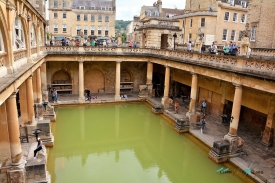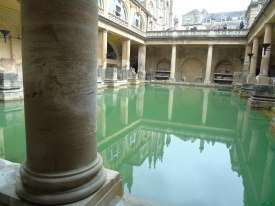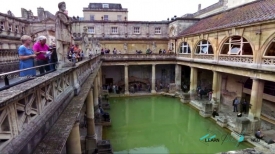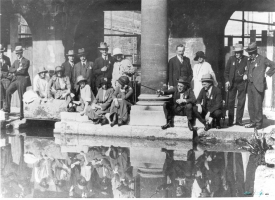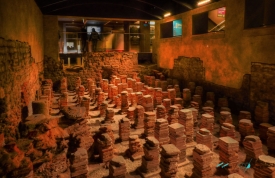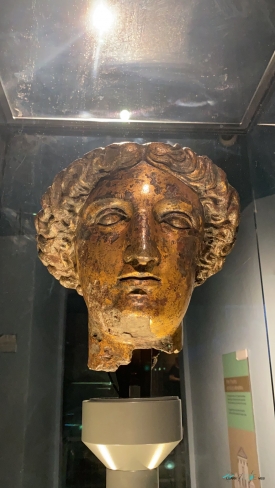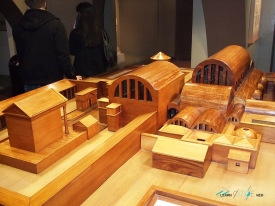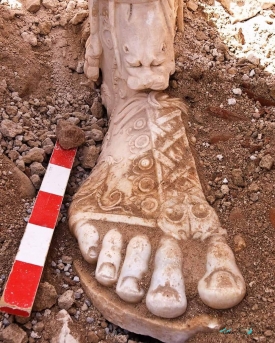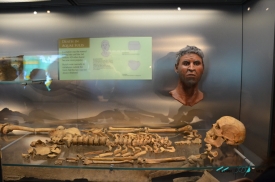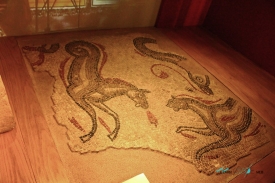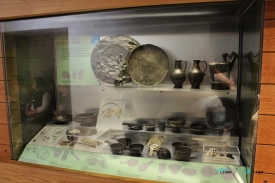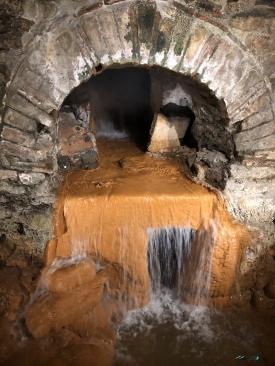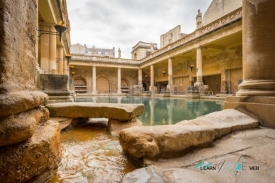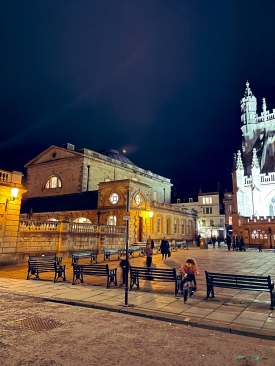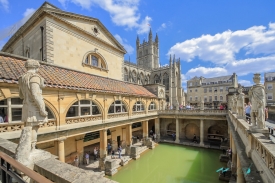The Roman Baths of Bath were built in the time of Emperor Vespasian, in AD 75, in the city then called Aquae Sulis. In fact, it seems that in this area, since 10000 BC, water leaked from the subsoil, still visible today.
They were known throughout the Roman Empire and frequented by people of all social classes. The complex also included a temple dedicated to Sulis, an ancient Celtic goddess of water, and to the Roman goddess Minerva.
In 410, with the abandonment of Britain by the Roman legions, the baths were abandoned and England was invaded by the Saxons, who conquered the city in 577. The structure fell into disrepair and was flooded. To stem the water, crushed stone was placed in the rooms, which with the water turned into blackish mud which submerged the baths.
The water that feeds Bath's hot springs first falls in the form of rain on the nearby Mendip Hills. Thanks to a series of underground tunnels, the water percolates to a depth between 2,700 and 4,300 meters, where a temperature between 69 and 96 ° C is reached due to geothermal energy. The water introduced in this way heats up and through natural fissures and porosity re-emerges on the surface. This process closely resembles the artificial one of improved geothermal systems, which also exploits the aforementioned properties of water, but to increase the production of electricity. The Baths, therefore, capture 1.17 million liters of hot water every day, which gushes from the ground at a temperature of 46 ° C.
The first to use the baths were the Celts, who built a sanctuary on the site dedicated to the goddess Sulis, adored by the Romans under the name of Minerva. Godfrey of Monmouth, in his Historia Regum Britanniae, attributes the discovery of the baths to the British prince Bladud, father of the Shakespearean king Lear. The rediscovery of this legend at the beginning of the eighteenth century significantly increased the myth of Bath: Godfrey, in fact, tells us how Bladud recovered from leprosy thanks to the healing properties of the water of this area.
The name of Sulis continued to be used even after the decline of the Celtic civilization, so much so that the Romans decided to baptize the city as Aquae Sulis ("the waters of Sulis"). The Romans, in fact, knew the thermal springs in 44 AD; the construction of the baths took place in 60-70, although the various alterations were only completed in the following three hundred years. During the Roman occupation of Britain, and possibly at the suggestion of Emperor Claudius, underground wooden structures were built to prevent the building from sinking into the mud. The source was also surrounded by a 2 meter high wall covered with lead sheets. In the third century, the baths were enclosed in a huge vaulted room, which included a modest calidarium ("hot", located to the west), a tepidarium ("warm") and a frigidarium ("cold", located to the south). Furthermore, the reconstruction of the roof also made it necessary to strengthen the walls with brick buttresses. The entire complex remained in use until the decline of Roman rule, after which it was covered up and finally flooded; the Anglo-Saxon Chronicle dates it to be abandoned in the 6th century.
The museum preserves a superb collection of Roman artifacts, found mainly in the Sacred Springs, as it indicates the votive nature of the finds. In the collection stand out the gilded bronze head of a statue of Minerva, returned by archaeological investigations of 1727, and a collection of 12,000 Roman coins. In the museum, the vestiges of the hypocaust are also kept, used to heat the calidarium of the thermal baths.
They were known throughout the Roman Empire and frequented by people of all social classes. The complex also included a temple dedicated to Sulis, an ancient Celtic goddess of water, and to the Roman goddess Minerva.
In 410, with the abandonment of Britain by the Roman legions, the baths were abandoned and England was invaded by the Saxons, who conquered the city in 577. The structure fell into disrepair and was flooded. To stem the water, crushed stone was placed in the rooms, which with the water turned into blackish mud which submerged the baths.
The water that feeds Bath's hot springs first falls in the form of rain on the nearby Mendip Hills. Thanks to a series of underground tunnels, the water percolates to a depth between 2,700 and 4,300 meters, where a temperature between 69 and 96 ° C is reached due to geothermal energy. The water introduced in this way heats up and through natural fissures and porosity re-emerges on the surface. This process closely resembles the artificial one of improved geothermal systems, which also exploits the aforementioned properties of water, but to increase the production of electricity. The Baths, therefore, capture 1.17 million liters of hot water every day, which gushes from the ground at a temperature of 46 ° C.
The first to use the baths were the Celts, who built a sanctuary on the site dedicated to the goddess Sulis, adored by the Romans under the name of Minerva. Godfrey of Monmouth, in his Historia Regum Britanniae, attributes the discovery of the baths to the British prince Bladud, father of the Shakespearean king Lear. The rediscovery of this legend at the beginning of the eighteenth century significantly increased the myth of Bath: Godfrey, in fact, tells us how Bladud recovered from leprosy thanks to the healing properties of the water of this area.
The name of Sulis continued to be used even after the decline of the Celtic civilization, so much so that the Romans decided to baptize the city as Aquae Sulis ("the waters of Sulis"). The Romans, in fact, knew the thermal springs in 44 AD; the construction of the baths took place in 60-70, although the various alterations were only completed in the following three hundred years. During the Roman occupation of Britain, and possibly at the suggestion of Emperor Claudius, underground wooden structures were built to prevent the building from sinking into the mud. The source was also surrounded by a 2 meter high wall covered with lead sheets. In the third century, the baths were enclosed in a huge vaulted room, which included a modest calidarium ("hot", located to the west), a tepidarium ("warm") and a frigidarium ("cold", located to the south). Furthermore, the reconstruction of the roof also made it necessary to strengthen the walls with brick buttresses. The entire complex remained in use until the decline of Roman rule, after which it was covered up and finally flooded; the Anglo-Saxon Chronicle dates it to be abandoned in the 6th century.
The museum preserves a superb collection of Roman artifacts, found mainly in the Sacred Springs, as it indicates the votive nature of the finds. In the collection stand out the gilded bronze head of a statue of Minerva, returned by archaeological investigations of 1727, and a collection of 12,000 Roman coins. In the museum, the vestiges of the hypocaust are also kept, used to heat the calidarium of the thermal baths.



